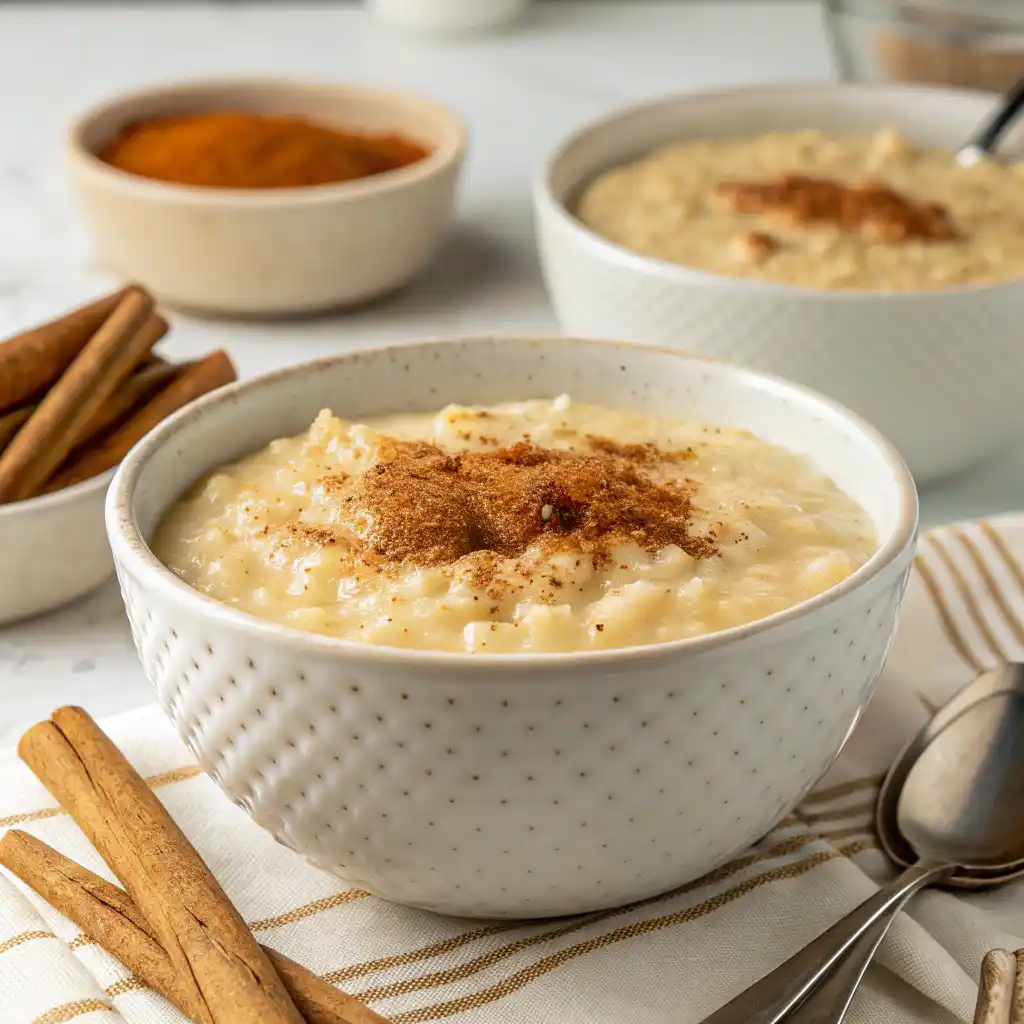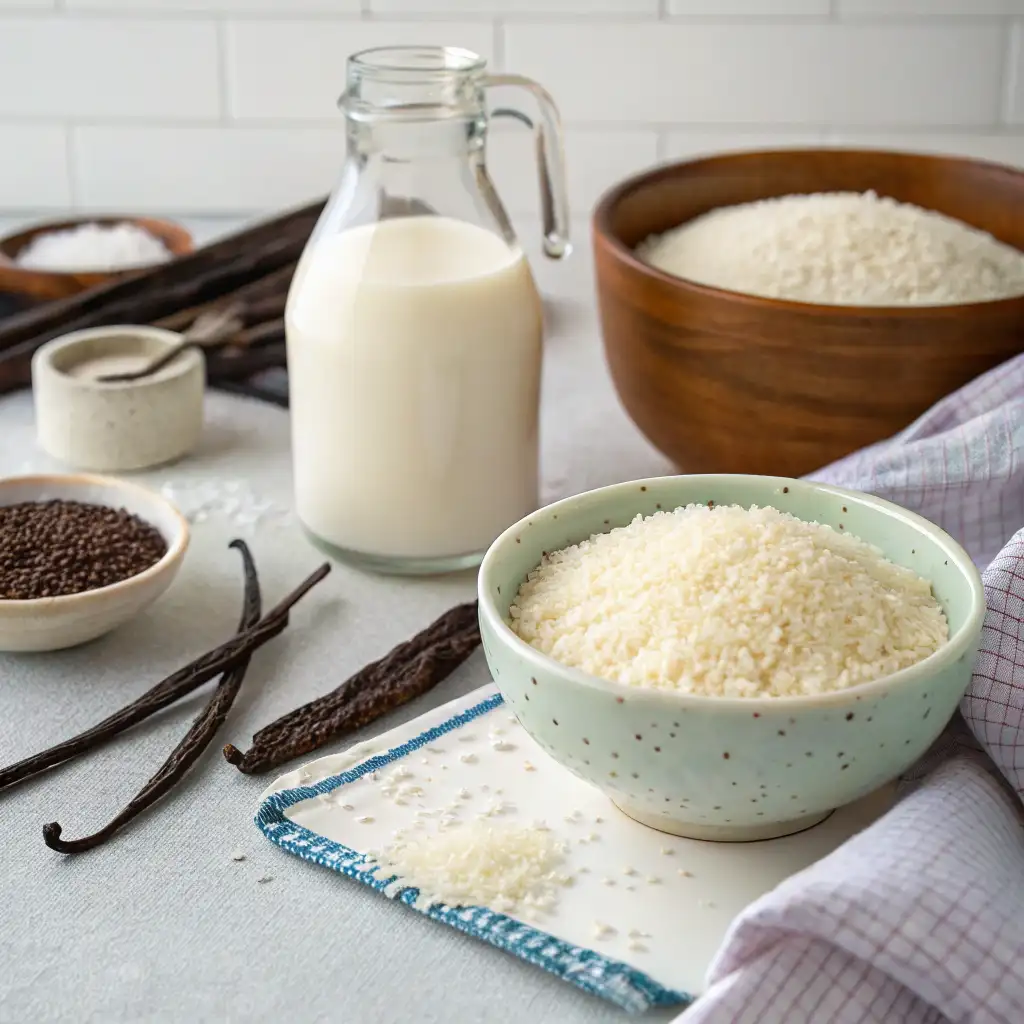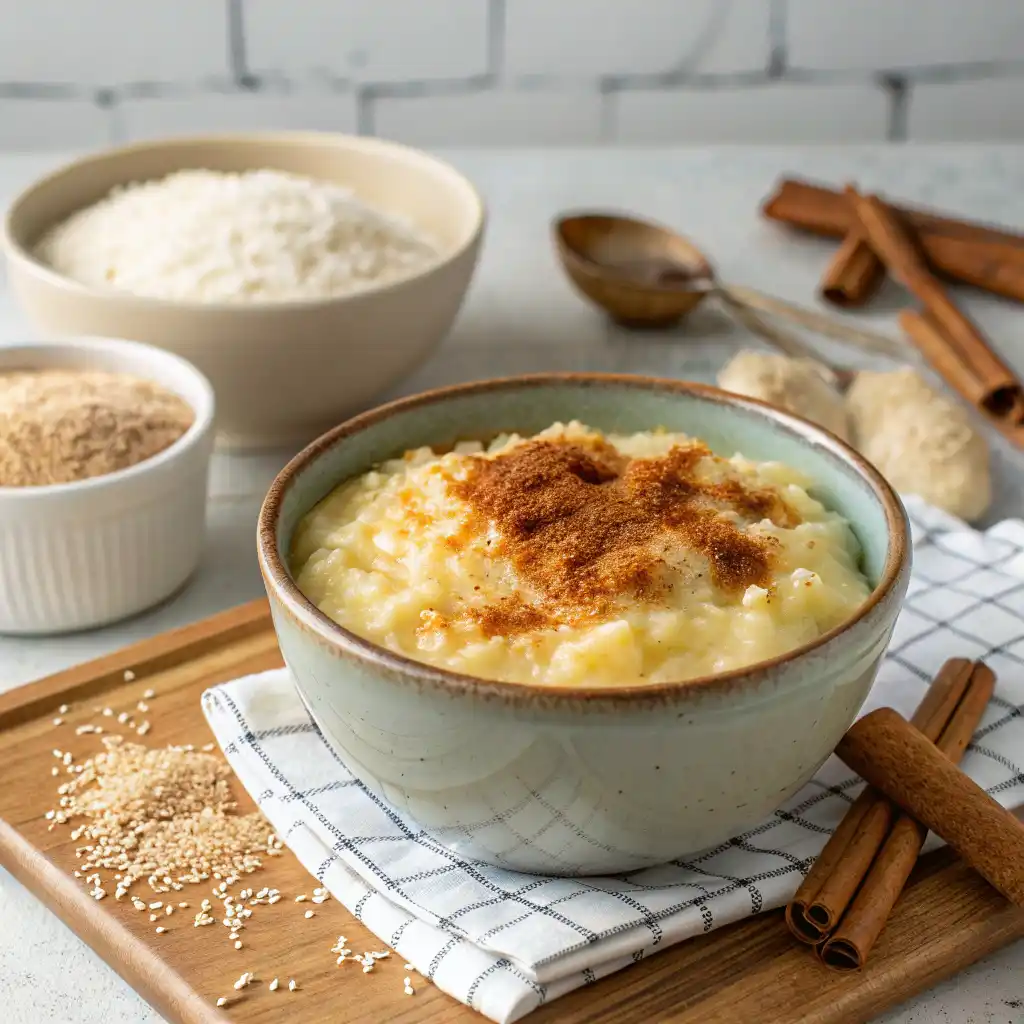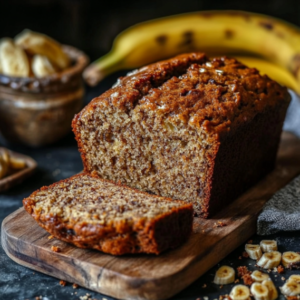Table of Contents
Introduction
There’s something utterly magical about transforming just three simple ingredients into a dessert so creamy, comforting, and delicately sweet that it has stood the test of time across generations. Rizogalo, the beloved Greek rice pudding, is exactly that kind of culinary alchemy. With just rice, milk, and sugar as its foundation, this humble dessert creates a silky, aromatic spoonful of comfort that warms both body and soul.
I remember my first taste of authentic rizogalo during a trip to a small Greek island, where an elderly yiayia (grandmother) served it still warm in small ceramic bowls, with a dusting of cinnamon creating a beautiful pattern on top. The simplicity was striking, yet the flavor was anything but basic.
What makes rizogalo truly special is how it bridges the gap between everyday cooking and something that feels utterly special. It’s quick enough for a weeknight treat yet elegant enough to serve to guests. Unlike my popular Baklava recipe that requires numerous ingredients and steps, rizogalo proves that sometimes, culinary magic happens with the fewest ingredients and simplest techniques.
So grab your favorite pot, those three magical ingredients, and let’s create a dessert that has been delighting families for centuries. I promise that once you master this recipe, it will become a treasured part of your culinary repertoire.
What is Rizogalo?

Ever wondered what happens when rice meets milk in the most delicious embrace possible? That’s rizogalo for you! This charming Greek dessert (pronounced ree-ZOH-gah-lo) literally translates to “rice-milk” – and isn’t that refreshingly straightforward? While Italians have their risotto and Spaniards their paella, the Greeks perfected turning rice into the creamiest, dreamiest dessert imaginable. As my Greek friend Eleni loves to joke, “Why court someone with fancy chocolates when rizogalo exists? In Greece, we know the way to anyone’s heart is through a bowl of warm rice pudding!” Don’t believe me? Just wait until your kitchen fills with the gentle aroma of vanilla-infused milk slowly transforming humble rice into something that feels like a warm hug in dessert form.
Why You’ll Love This Rizogalo:
Rizogalo is comfort in a bowl, with a silky, creamy texture that soothes your soul with each spoonful. The star of this dish is undoubtedly the perfect balance between the tender rice grains and the velvety milk base that surrounds them – creating a texture that’s somehow both substantial and delicate at the same time.
Making rizogalo at home costs a fraction of what you’d pay at specialty Greek bakeries or restaurants. With just three primary ingredients that are likely already in your pantry and refrigerator, this budget-friendly dessert feels luxurious despite its humble components. It’s proof that extraordinary flavor doesn’t require expensive ingredients or complicated techniques.
The beauty of rizogalo lies in how it becomes a canvas for your favorite toppings. Whether you choose the traditional cinnamon sprinkle, a drizzle of honey, or fresh seasonal fruits, each addition transforms the base recipe into something uniquely yours. I particularly love adding a small spoonful of cherry preserves for a tangy contrast to the sweetness.
If you enjoy the comforting qualities of rizogalo, you’ll also appreciate my Galaktoboureko recipe, where similar flavors are wrapped in crispy phyllo dough. Why not try both and host a Greek dessert night? Your family will thank you!
How to Make Rizogalo:
Quick Overview
Rizogalo is the epitome of simplicity transformed into luxury. This creamy, comforting Greek rice pudding comes together with minimal effort but delivers maximum satisfaction. The slow-cooked rice releases its starch to create a naturally thick, velvety texture that feels indulgent with every spoonful. Best of all, you’ll need just 35 minutes from start to finish, making this an achievable dessert even on busy weeknights.
Key Ingredients for Rizogalo:

- 1 cup medium-grain rice (Arborio or Carnaroli work wonderfully)
- 4 cups whole milk
- 3/4 cup granulated sugar
- 1 cinnamon stick
- 1 strip of lemon zest (about 2 inches long)
- 1 teaspoon vanilla extract
- Pinch of salt
- Ground cinnamon for serving
Step-by-Step Instructions:
- Rinse the rice thoroughly under cold water until the water runs clear. This removes excess starch and prevents the rizogalo from becoming too gummy.
- In a large, heavy-bottomed pot, combine the rice, milk, sugar, cinnamon stick, and lemon zest. Add a small pinch of salt to enhance the sweetness.
- Bring the mixture to a gentle simmer over medium heat, stirring frequently to prevent the rice from sticking to the bottom of the pot. This will take approximately 5-7 minutes.
- Once simmering, reduce the heat to low. You want to maintain a very gentle bubbling – not a rolling boil. Continue cooking for about 20-25 minutes, stirring often, until the rice is tender and the mixture has thickened significantly.
- Remember this dessert will continue to thicken as it cools, so remove it from heat when it’s slightly looser than your desired final consistency.
- Remove the cinnamon stick and lemon zest. Stir in the vanilla extract, mixing thoroughly to distribute the flavor.
- Transfer the warm this dessert to individual serving bowls or a large serving dish. Press a piece of plastic wrap directly onto the surface if you want to prevent a skin from forming (though some traditionalists consider this skin part of the authentic experience!).
- Allow to cool slightly before serving warm, or refrigerate for at least 2 hours if you prefer it cold. Just before serving, dust the top with a generous sprinkle of ground cinnamon.
What to Serve Rizogalo With:
this dessert shines as both a standalone dessert and as part of a larger spread. For an authentic Greek experience, serve small bowls alongside strong Greek coffee or a shot of ouzo for adults. It pairs beautifully with fresh seasonal fruits – think sliced peaches or berries in summer, or poached pears in winter. For a more substantial dessert spread, offer rizogalo alongside other Greek classics like baklava or kataifi for a textural contrast to its creaminess. If serving for breakfast or brunch, consider adding a drizzle of honey and some toasted walnuts or almonds for added protein and crunch. For a truly decadent treat, serve warm this dessert with a small scoop of vanilla ice cream melting on top – the temperature contrast creates a delightful sensory experience.
Top Tips for Perfecting Rizogalo:
The secret to truly exceptional rizogalo lies in patience and attention to detail. Keep your heat consistently low once the mixture begins to simmer – rushing the cooking process with higher heat will result in unevenly cooked rice and a less creamy texture. Stir frequently, but not constantly, to develop the pudding’s natural creaminess without breaking down the rice grains too much.
For ingredient substitutions, while traditional rizogalo uses whole milk, you can experiment with alternatives. For an ultra-luxurious version, replace one cup of milk with heavy cream. If making a dairy-free version, coconut milk creates a delightful tropical variation, though the flavor profile will change significantly.
The biggest mistake novice rizogalo makers encounter is removing it from heat too late. Remember that the pudding continues to thicken substantially as it cools. Remove it from heat when it still seems slightly too loose – it should coat the back of a wooden spoon but still flow slowly when the spoon is tilted.
If your rizogalo becomes too thick after cooling, simply whisk in a splash of warm milk before serving to restore its creamy consistency. Conversely, if it’s too thin, a quick simmer with a teaspoon of cornstarch dissolved in cold water can help thicken it.
Storing and Reheating Tips:
Rizogalo stores beautifully, making it an excellent make-ahead dessert option. To store leftovers, transfer the cooled pudding to an airtight container and refrigerate for up to 4 days. Place a piece of plastic wrap directly on the surface of the pudding before closing the container to prevent a skin from forming (unless you enjoy that textural element).
Rizogalo can also be frozen for longer storage, though there may be slight textural changes upon thawing. Transfer to freezer-safe containers, leaving a half-inch of space for expansion, and freeze for up to 2 months. Thaw overnight in the refrigerator before serving or reheating.
When reheating refrigerated rizogalo, place the desired portion in a small saucepan with a splash of milk (about 1-2 tablespoons per cup of pudding) and warm over low heat, stirring frequently. Alternatively, microwave individual portions at 50% power in 30-second intervals, stirring between each, until warmed to your preference. Add a sprinkle of fresh cinnamon after reheating to revive the aroma.
For a creative twist on leftovers, try spreading cold rizogalo between layers of phyllo dough, brushed with butter, and baking until golden for a simple version of a milk pie – proving that this versatile dessert can transform into something entirely new for its second act.
For more Greek recipes, visit this link : Ultimate Guide to Greek Breakfast
Can I use any type of rice to make Rizogalo?
While you can technically use different rice varieties, not all will give you the authentic creamy texture that makes rizogalo special. Medium-grain rice varieties like Arborio or Carnaroli (typically used for risotto) work best because they release more starch during cooking, creating that signature creamy consistency. Long-grain rice like Basmati or Jasmine won’t break down as much during cooking, resulting in a less creamy pudding with more distinct grains. Short-grain rice like sushi rice can work in a pinch, but may create a slightly gummier texture. Avoid instant or parboiled rice varieties completely, as they won’t develop the proper creaminess that defines authentic rizogalo
Is Rizogalo served hot or cold?
One of the wonderful things about rizogalo is its versatility! Traditionally, Greek rizogalo can be enjoyed both ways, depending on personal preference and the season. Many Greeks serve it slightly warm or at room temperature with a dusting of cinnamon on top, especially during cooler months. The warm version offers comforting qualities similar to other hot puddings. However, chilled rizogalo is particularly refreshing during summer and allows the pudding to set to a firmer consistency. If serving cold, refrigerate for at least 2-3 hours before serving. Some families have strong traditions about which way is “correct,” but both serving temperatures are authentically Greek and delicious in their own way!
Can I make Rizogalo dairy-free or vegan?
Absolutely! While traditional rizogalo is made with dairy milk, you can create a delicious dairy-free or vegan version with excellent results. The best plant-based milk substitutes for rizogalo are full-fat coconut milk or oat milk, as they provide the creaminess needed for authentic texture. Almond milk works too, though the pudding may be slightly less rich. You’ll want to avoid rice milk (ironically) as it’s typically too thin. Replace the sugar with an equal amount of organic cane sugar or coconut sugar for a fully vegan version. The cooking process remains the same, though plant-based versions may take slightly longer to thicken. Some dairy-free milks thicken less than cow’s milk, so you might need to reduce the liquid by about 1/4 cup or add a tablespoon of cornstarch mixed with cold water during the final few minutes of cooking.




